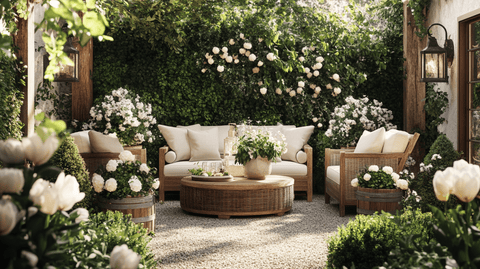Does this look familiar?

Are you tired of being labeled as someone with a "black thumb"? Do you long for the benefits of having houseplants but fear that you just don't have what it takes to keep them alive? Well, fear not! In this article, we will debunk common misconceptions about having a "green thumb" and provide you with a comprehensive guide to low-maintenance houseplants that even the most inexperienced gardener can successfully care for.
Challenges of Caring for Houseplants
Caring for houseplants can be a daunting task, but understanding the challenges that contribute to plant failure can help you overcome them. Factors such as improper lighting, overwatering, and neglect can all lead to the demise of your houseplants. Furthermore, many people make common mistakes when caring for plants, such as using the wrong type of soil or forgetting to fertilize. By recognizing these challenges and avoiding these mistakes, you can set yourself up for success in caring for your plants.
Low-Maintenance Options
Snake Plant (Sansevieria Trifasciata)

If you're looking for a foolproof plant, look no further than the Snake Plant. With its striking appearance and ability to thrive in a variety of conditions, it's the perfect choice for beginners. The Snake Plant has long, stiff leaves that are usually green with yellow or white patterns. It requires minimal water and can withstand low light levels, making it an ideal choice for any room in your home. To care for your Snake Plant, simply place it in a well-draining potting mix and water it sparingly, allowing the soil to dry out completely between waterings.
ZZ Plant (Zamioculcas Zamiifolia)

Another great option for low-maintenance houseplants is the ZZ Plant. This plant is known for its glossy, dark green leaves that are arranged in a graceful, arching pattern. It is highly adaptable and can tolerate low light and irregular watering. The ZZ Plant is a slow grower, so you won't have to worry about constant pruning or repotting. When it comes to care, simply place your ZZ Plant in a well-draining pot and water it when the top inch of soil feels dry.
Pothos (Epipremnum Aureum)

If you're looking for a versatile and resilient houseplant, the Pothos is an excellent choice. With its trailing vines and heart-shaped leaves, it adds a touch of elegance to any space. Pothos plants come in a variety of colors, including green, golden, and variegated, making them a popular choice among plant enthusiasts. Pothos plants are forgiving when it comes to lighting and watering, and they can even tolerate some neglect. To care for your Pothos, place it in a well-draining potting mix and water it when the top inch of soil feels dry.
Spider Plant (Chlorophytum Comosum)

Last but not least, we have the Spider Plant. With its arching leaves and cascading baby spiderettes, it's a delightful addition to any home. Spider Plants are known for their ability to purify the air and are highly adaptable to different environments. They thrive in bright, indirect light and prefer slightly moist soil. However, they can tolerate periods of drought, making them a forgiving choice for beginners. Simply plant your Spider Plant in a well-draining potting mix, water it when the top inch of soil feels dry, and watch it thrive!
Tips for Successful Houseplant Care
Now that you know which low-maintenance houseplants to choose, let's explore some tips for successful care:

Finding the Right Spot in Your Home
Consider the lighting requirements of your houseplants and place them in the appropriate spot in your home. Some plants thrive in bright, indirect light, while others prefer low light conditions. By finding the right spot for your plants, you can ensure they receive the proper amount of light to thrive.
Watering Techniques and Frequency
A common mistake people make is overwatering their houseplants. It's important to water your plants appropriately based on their individual needs. Some plants prefer drier conditions, while others require more frequent watering. Always check the moisture level of the soil before watering and adjust accordingly.
Proper Fertilization and Repotting Guidelines
While low-maintenance houseplants generally require minimal fertilization, it's still essential to provide them with the nutrients they need to stay healthy. Choose a balanced fertilizer and follow the package instructions for application. Additionally, keep an eye on the growth of your plants and repot them when they outgrow their current containers.

Monitoring for Pests and Disease Prevention
Pests and diseases can quickly wreak havoc on your houseplants. Regularly inspect your plants for signs of pests such as aphids or spider mites and take appropriate action to control them. Additionally, practice good hygiene by cleaning your plants' leaves and removing any dead or yellowing foliage to prevent disease.

Buy Some Plants for Your Home!
You don't need a "green thumb" to enjoy the benefits of having houseplants. By choosing low-maintenance options like the Snake Plant, ZZ Plant, Pothos, and Spider Plant, you can successfully care for your houseplants even if you're a beginner. Remember to find the right spot for your plants, water them appropriately, provide necessary fertilization and repotting, and keep an eye out for pests and disease. With these tips in mind, you'll be well on your way to creating a green and thriving indoor oasis!































Comments (0)
There are no comments for this article. Be the first one to leave a message!